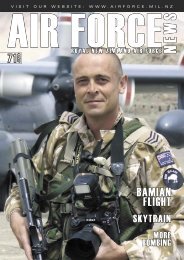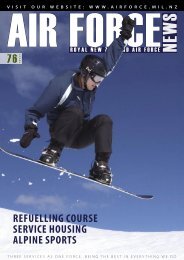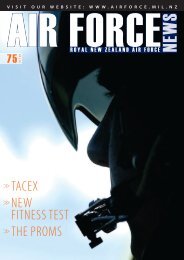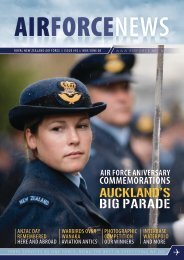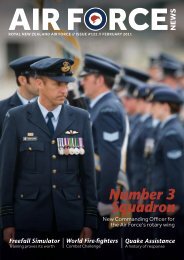February 2007, Issue 78 [pdf 3mb, 44 pages] - Royal New Zealand ...
February 2007, Issue 78 [pdf 3mb, 44 pages] - Royal New Zealand ...
February 2007, Issue 78 [pdf 3mb, 44 pages] - Royal New Zealand ...
You also want an ePaper? Increase the reach of your titles
YUMPU automatically turns print PDFs into web optimized ePapers that Google loves.
26<br />
C I S O C O U R S E C I S O C O U R S E<br />
BACK TO SCHOOL<br />
FOR CIS OFFICERS<br />
For five officers from the RNZAF’s newest trade, it was back to school at RNZAF Base Woodbourne<br />
last October. 06-1 Communication and Information Systems Officer Course (CISOC) was the first<br />
formal training of its kind undertaken by the RNZAF since 1998.PLTOFF Jim Sheehan explains.<br />
Although CISO training is designed to<br />
meet the needs of newer Branch members,<br />
the five graduates of 06-1 CISOC have<br />
collectively amassed a surprising 65 years<br />
of military experience. The reason for<br />
this is the unusual range of service time<br />
completed by members of the CISOC<br />
- it ranges from just under 2 years in the<br />
RNZAF to more than 31 years <strong>Royal</strong> Signals<br />
experience.<br />
The successful push to revive and launch<br />
CISO training was a culmination of effort<br />
on the part of the Air Staff CIS Branch<br />
team, WGCDR Steve Alexander (DCIS(F)),<br />
SQNLDR Rhys Taylor (ADACIS and 06-<br />
1 CISO Course Manager), W/O Tony<br />
Johnstone (SOCIS) and Mr Nick Burrows<br />
(ADIS).<br />
In determining the content of the course,<br />
DCIS(F) examined the syllabus produced<br />
for the now-defunct Comms Officer<br />
Branch, and set to work reshaping the<br />
material to align with current operational<br />
requirements, and to equip the candidates<br />
to handle the depth and breadth of<br />
professional challenges presented daily in<br />
the RNZAF’s CIS Trade.<br />
The range of professional responsibility<br />
vested in junior CISOs is getting broader<br />
by the day, as both NZDF requirements<br />
and information technology continue to<br />
generate endless cycles of progressive<br />
change.<br />
The foremost question throughout the<br />
revamp process was ‘Why?’ DCIS(F)<br />
rationale for this is that it is vital we<br />
understand ‘why’ we do things, why we<br />
don’t do things and even why we exist.<br />
This focused the course in a manner which<br />
inculcated a strong sense of professional<br />
purpose. After much hacking and slashing,<br />
the original 12-week course was reduced<br />
to seven weeks and included visits to almost<br />
all NZDF camps and Bases. Unfortunately,<br />
weather in Palmerston North (yes, Palmy,<br />
not Wellington!) meant the cancellation<br />
of visits to 1 RNZIR and 2 SIGS SQN at<br />
Linton.<br />
CIS Sections routinely provide services<br />
such as long distance Command & Control<br />
(C2) communications for missions via HF<br />
radio (the RNZAF has HF radio sites located<br />
in Auckland and Christchurch which are<br />
remotely accessed from its Air Operations<br />
Communication Centre at Whenuapai).<br />
There is also a significant expeditionary<br />
communications inventory which deploys<br />
in support of NZDF and RNZAF missions<br />
and exercises, all of which require detailed<br />
planning and collaboration with HQ JFNZ.<br />
<strong>New</strong> technologies are providing increased<br />
scope for individual members of the NZDF<br />
to be self-sufficient in CIS, but there is a<br />
corresponding demand for ESS and FE unitlevel<br />
training in the handling requirements<br />
and operation of CIS equipment such as<br />
AFN<strong>78</strong> FEBRUARY 07 www.airforce.mil.nz<br />
WN 07-0058-03<br />
WN 07-0058-01<br />
ABOVE: CISO course members gaze into the Sun at IPS.<br />
LEFT: Mr Eric Jones from Stratos points out Asia Sat 4 in orbit.<br />
BELOW LEFT: CIS meet their equvalent RAAF 1 Combat Communications Squadron.<br />
BELOW RIGHT: SGT Stu Middendorf guides the course through a deployable communications centre.<br />
‘ The range of professional responsibility<br />
vested in junior CISOs is getting broader<br />
by the day, as both NZDF requirements and<br />
information technology continue to generate<br />
endless cycles of progressive change.<br />
’<br />
handheld and manpack military radios,<br />
satellite terminals, and Communications<br />
Security (COMSEC) devices.<br />
A large portion of the course was<br />
dedicated to the planning processes<br />
required for CIS deployments. This is a<br />
rapidly expanding commitment for CIS,<br />
as most JFNZ deployments require the<br />
continuous support of CIS elements. After<br />
initial classroom lessons, the CISO Course<br />
were given a hypothetical CIS scenario<br />
based on deploying to a Pacific island in<br />
the midst of a political crisis. A Tactical<br />
Communications Unit (TCU) was created<br />
to provide support. Questions such as<br />
‘Which satellite, and what HF circuits do<br />
we require?’, ‘What pack-up configuration<br />
can be despatched by C-130?’, ‘Will<br />
they need JEMS?’, ‘What are the IERs?<br />
(Information Exchange Requirements) of<br />
the deploying FE?’.<br />
To recognise the changing role of RNZAF<br />
AFN<strong>78</strong> FEBRUARY 07 www.airforce.mil.nz<br />
CIS, the course also focused on topics<br />
such as:<br />
satellite communications<br />
concepts of airworthiness<br />
Electronic Warfare<br />
deployment of NZDF CIS<br />
Network Enabled Capability<br />
coalition (Allied) interoperability<br />
Before probing too deeply into the<br />
future, time was also spent exploring the<br />
advantages (and disadvantages) of existing<br />
RNZAF systems and inventory, much of<br />
which has been recently upgraded. Radio<br />
systems, particularly HF and V/UHF,<br />
were covered. HF radio systems require<br />
professional management if they are to<br />
avoid falling victim to the geophysical<br />
effects from sunspots, or disturbances in the<br />
Earth’s geomagnetic state, thus generating<br />
more classroom time for the CISOC.<br />
The course ended with a visit to Australian<br />
units and organisations with whom RNZAF<br />
WN 07-0058-04<br />
WN 07-0058-02<br />
CIS frequently operates. ADF units visited<br />
included HQACAUST (Air Command<br />
Australia) at RAAF Glenbrook, 1CCS<br />
(Combat Communications Squadron) at<br />
RAAF Richmond, Ionospheric Prediction<br />
Services (IPS), and HQJOC located<br />
alongside HMAS Kuttabul in Sydney.<br />
Following a drive to Canberra, the course<br />
visited the ADF’s sole HF communications<br />
station which is the hub of a modernised<br />
HF communications network, and finally<br />
COMPUCAT Australia, a private company<br />
with significant Defence involvement<br />
around the world. COMPUCAT have<br />
provided CMX and a suite of other<br />
world-class communications and security<br />
products to the RNZAF. It is also the NZDF<br />
contractor for the networked integration of<br />
HF radio equipment recently purchased by<br />
the RNZAF.<br />
Often sweltering Aussie conditions posed<br />
little threat to the hardened CISOs. Sydney<br />
resembled Waiouru in at least one respect<br />
as it hosted the CISO course to its coldest<br />
day in one hundred years.<br />
The conclusion of the visit to Australia<br />
meant it was time for the mad dash<br />
to connecting flights home, and more<br />
importantly, to graduate as the RNZAF’s<br />
newest CISOs at Woodbourne on 17<br />
November 2006. A CISO course will<br />
now be held every two years, and will<br />
use the work that DCIS(F) and his team<br />
have completed and refined to ensure<br />
the RNZAF CISO branch keeps abreast<br />
of the rapidly changing world of CIS.<br />
The activities CIS now conduct are<br />
different from those conducted six months<br />
previously, and six months from now, they<br />
will be different again. CIS, C4ISR, NEC<br />
and Intelligence are among the fastest<br />
developing fields throughout the world’s<br />
defence organisations.<br />
By the time 06-1 CISOC graduates reach<br />
the appointment of DCIS(F), the RNZAF<br />
and its CIS Branch will have changed<br />
dramatically and they may be looking to<br />
become the first CISO appointed to the<br />
role of NZDF Chief Information Officer.<br />
One thing, however, will remain constant.<br />
The CISOs we produce right now, and in<br />
the future, will all strive to make the RNZAF<br />
CIS Branch a successful and respected<br />
provider of capability – and to quote<br />
WGCDR Alexander, ‘to be the best little<br />
CIS Branch in the world’.


![February 2007, Issue 78 [pdf 3mb, 44 pages] - Royal New Zealand ...](https://img.yumpu.com/17485296/26/500x640/february-2007-issue-78-pdf-3mb-44-pages-royal-new-zealand-.jpg)
